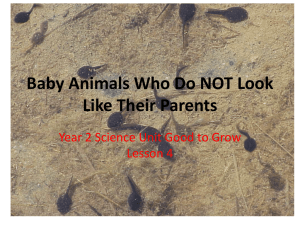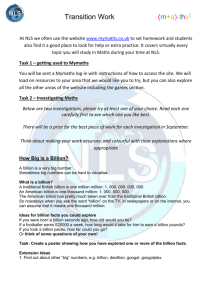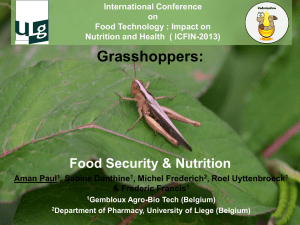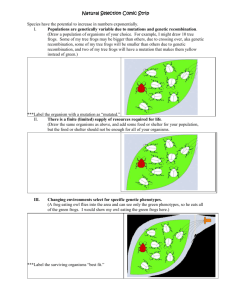The Food Web Game
advertisement
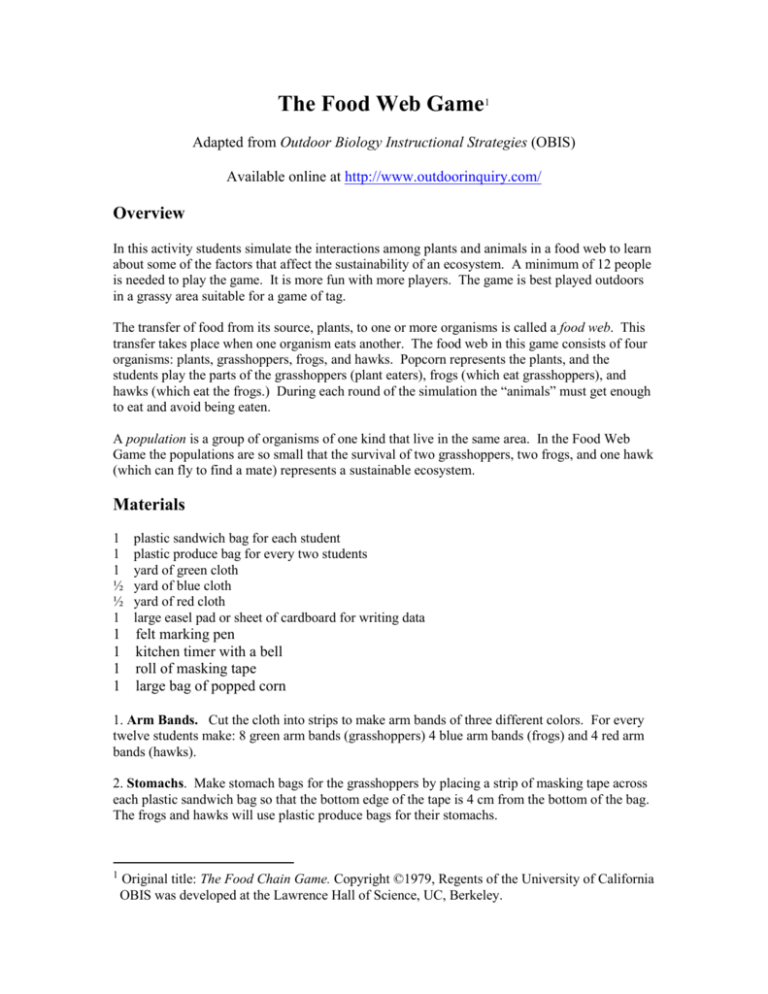
The Food Web Game1 Adapted from Outdoor Biology Instructional Strategies (OBIS) Available online at http://www.outdoorinquiry.com/ Overview In this activity students simulate the interactions among plants and animals in a food web to learn about some of the factors that affect the sustainability of an ecosystem. A minimum of 12 people is needed to play the game. It is more fun with more players. The game is best played outdoors in a grassy area suitable for a game of tag. The transfer of food from its source, plants, to one or more organisms is called a food web. This transfer takes place when one organism eats another. The food web in this game consists of four organisms: plants, grasshoppers, frogs, and hawks. Popcorn represents the plants, and the students play the parts of the grasshoppers (plant eaters), frogs (which eat grasshoppers), and hawks (which eat the frogs.) During each round of the simulation the “animals” must get enough to eat and avoid being eaten. A population is a group of organisms of one kind that live in the same area. In the Food Web Game the populations are so small that the survival of two grasshoppers, two frogs, and one hawk (which can fly to find a mate) represents a sustainable ecosystem. Materials 1 1 1 ½ ½ 1 plastic sandwich bag for each student plastic produce bag for every two students yard of green cloth yard of blue cloth yard of red cloth large easel pad or sheet of cardboard for writing data 1 felt marking pen 1 kitchen timer with a bell 1 roll of masking tape 1 large bag of popped corn 1. Arm Bands. Cut the cloth into strips to make arm bands of three different colors. For every twelve students make: 8 green arm bands (grasshoppers) 4 blue arm bands (frogs) and 4 red arm bands (hawks). 2. Stomachs. Make stomach bags for the grasshoppers by placing a strip of masking tape across each plastic sandwich bag so that the bottom edge of the tape is 4 cm from the bottom of the bag. The frogs and hawks will use plastic produce bags for their stomachs. 1 Original title: The Food Chain Game. Copyright ©1979, Regents of the University of California OBIS was developed at the Lawrence Hall of Science, UC, Berkeley. Action 1. Introduce food webs. Diagram the plants grasshoppers frogs hawks food web on the data board. Explain that the transfer of food from its source, plants, to one or more organisms is called a food web. You have drawn just a few of the organisms in a typical food web. Explain that for this game you will pretend that these are the only organisms in the food web. 2. Introduce the game. Tell the students that they are going to be playing the part of grasshoppers, frogs and hawks in a food web game to learn more about how food webs function. 3. Spread out the plants. Scatter most of the popcorn over the area, and explain that the popcorn represents plants that grasshoppers eat. 4. Assign parts. Divide the students equally into three groups and distribute grasshopper arm bands to one group, frog arm bands to the second group, and hawk arm bands to the third group. (You will have some grasshopper sashes left over). Ask the students to help each other tie an arm band onto each others arms, and make sure the students know which role they will play in the game. 5. Outline the rules. Give each “animal” one stomach. The “grasshoppers” get the smallest stomachs marked with tape. The “frogs” and “hawks” get plastic produce bags. Explain that when the game starts the grasshoppers will try to eat popcorn plants (pick up popcorn and put into their stomach bags) the frogs will try to eat grasshoppers (tag them), and the hawks will try to eat the frogs. When a frog tags a grasshopper the frog takes the grasshopper’s stomach and the grasshopper leaves the game. When a hawk tags a frog, the hawk takes the frog’s stomach and the frog leaves the game. This simulates the transfer of food energy when one organism eats another. a. Emphasis that grasshoppers can feed only on the popcorn plants on the ground. Frogs can feed only on grasshoppers, and hawks can feed only on frogs. b. Animals that are eaten (tagged) must wait on the sidelines for the next round. c. Announce that the round will last five minutes or until all of one kind of animal are eaten. 6. Play the game. Record the starting population numbers on the data board. Set the timer for five minutes, and yell “Go!” The first round often lasts only a few seconds because all the hoppers or frogs are quickly “eaten.” 7. Count survivors. After the first round record on the data board the number of each kind of animal that obtained enough food to survive. To survive a grasshopper’s stomach must be filled to the bottom of the tape (4 cm), a frog must have three full grasshoppers’ stomachs, and a hawk must have one full frog’s stomach. Animals with less than a full stomach at the end of a round “starve to death.” 8. Modify the initial conditions. Explain that at least two grasshoppers, two frogs, and one hawk must be alive at the end of a five-minute round to have a “sustainable” food web. Ask the students how they can change the game to produce a sustainable food web. Typical suggestions include: Increase the number of grasshoppers. Provide more plants (popcorn). Set up safety zones for the grasshoppers and frogs to hide from the hawk. Allow the grasshoppers to forage for 30 seconds before the frogs “wake up.” 9. Play another round. Record on the data board the suggestions the group wants to try next. Make the necessary arm band changes and return the popcorn to the activity site. Record starting populations, reset the timer, and play the game again. A sample data board is shown below. Round 1 Round 2 None Safety Zone Special Rules Star t Survivor s Star t Hawks 8 0 16 Frogs 8 1 6 Grasshopper s 8 0 2 Survivor s Round 3 Star t Survivor s 10. Continue modifying initial conditions. Play additional rounds, changing the initial conditions, until the food web becomes sustainable; with at least two grasshoppers, two frogs, and one live hawk surviving at the end of the round. Record the initial conditions and surviving organisms at the end of each round. Encourage the students to reflect on previous rounds before suggesting how to run the next round. 11. Draw conclusions. At the end of the entire game ask students to reflect on all previous trials and to suggest what they have learned what it takes for food webs to be sustainable. The ask some more directed questions, such as: What population sizes of grasshoppers, frogs, and hawks produce a sustainable food web? What might happen if there were only half as many popcorn plants? No plants? Many more plants? If there were no frogs what might happen to the plant population? The grasshopper population? The hawk population? What are some food webs that include humans? Going Further (Optional) Look for evidence of plants being eaten in the activity site. What animals are responsible? What animals might be around that eat those animals? Play new versions of the game that include one or more additional organisms (people, scavengers, decomposers). Or scatter a small amount of colored popcorn that represents toxic waste. Have students count the number of “toxic” plants they have eaten, noting how the number increases the higher you go in the food web. Discussion Review the following standards and performance expectations. Which of the following Performance Expectations do you think students in grades 6-8 would be able to demonstrate when doing this activity? What were the specific components of the Food Web activity that supports the opportunity for students to learn the standard or demonstrate the performance expectation? What student based evidence would you need to observe or collect in order to evaluate if they have learned the associated content standard? 6-8 LS2A 6-8 LS2D 6-8 INQE Model 6-8 SYSB 6-8 SYSF Content Standards Performance Expectations Students know that: Students are expected to: An ecosystem consists of all the populations living within a specific area and the nonliving factors they interact with. One geographical area may contain many ecosystems. Explain that an ecosystem is a defined area that contains populations of organisms and nonliving factors. Give examples of ecosystems (e.g., Olympic National Forest, Puget Sound, one square foot of lawn) and describe their boundaries and contents. Ecosystems are continuously changing. Causes of these changes include nonliving factors such as the amount of light, range of temperatures, and availability of water, as well as living factors such as the disappearance of different species through disease, predation, and overuse of resources or the introduction of new species. Models are used to represent objects, events, systems, and processes. Models can be used to test hypotheses and better understand phenomena, but they have limitations. The boundaries of a system can be drawn differently depending on the features of the system being investigated, the size of the system, and the purpose of the investigation. The natural and designed world is complex; it is too large and complicated to investigate and comprehend all at once. Scientists and students learn to define small portions for the convenience of investigation. The units of investigation can be referred to as “systems.” Predict what may happen to an ecosystem if nonliving factors change (e.g., the amount of light, range of temperatures, or availability of water), or if one or more populations are removed from or added to the ecosystem. Create a model or simulation to represent the behavior of objects, events, systems, or processes. Use the model to explore the relationship between two variables and point out how the model or simulation is similar to or different from the actual phenomenon. Explain how the boundaries of a system can be drawn to fit the purpose of the study (e.g., to study how insect populations change, a system might be a forest, a meadow in the forest, or a single tree). Given a complex societal issue with strong science and technology components (e.g., overfishing, global warming), describe the issue from a systems point of view, highlighting how changes in one part of the system are likely to influence other parts of the system.


